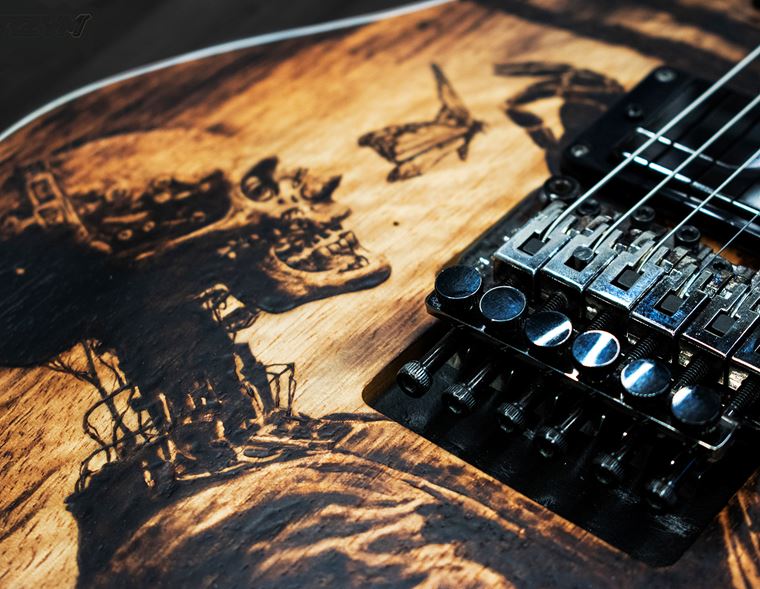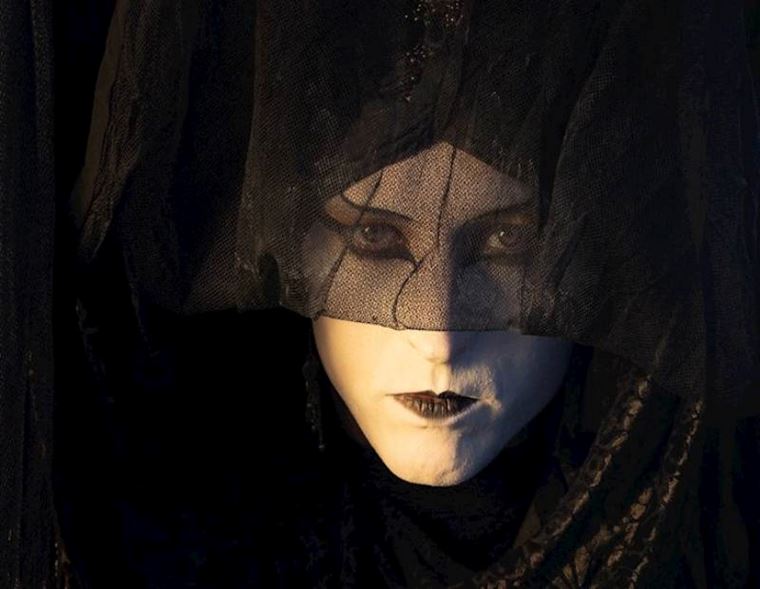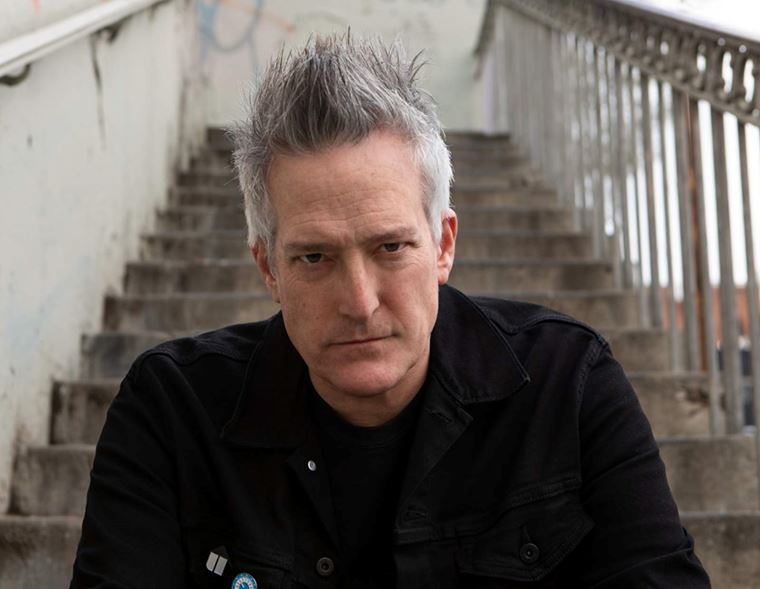MR BUNGLE: Scott Ian & Trey Spruance on The Raging Wrath of the Easter Bunny
What kind of band are Mr Bungle?
That’s not an easy question to answer, which you’ll know if you’ve listened to any of their records. The carnival-esque oblique metal of their debut self-titled record is a million miles from the mysterious David Lynch-style twang and midnight-crooning of their third record, California. They go form monstrously heavy to pleasantly melodic within the space of a heartbeat, with a bubbling-under lunacy that provides an off-kilter context to their work.
Whilst impossible to characterise, they certainly have a reputation. Known as mavericks, virtuosos, practical jokers and experimentalists, they’ve carved themselves a very particular niche within modern culture. Mr Bungle are one of those bands that not everybody likes, but those that do, love them. Isn’t that true of most great bands?
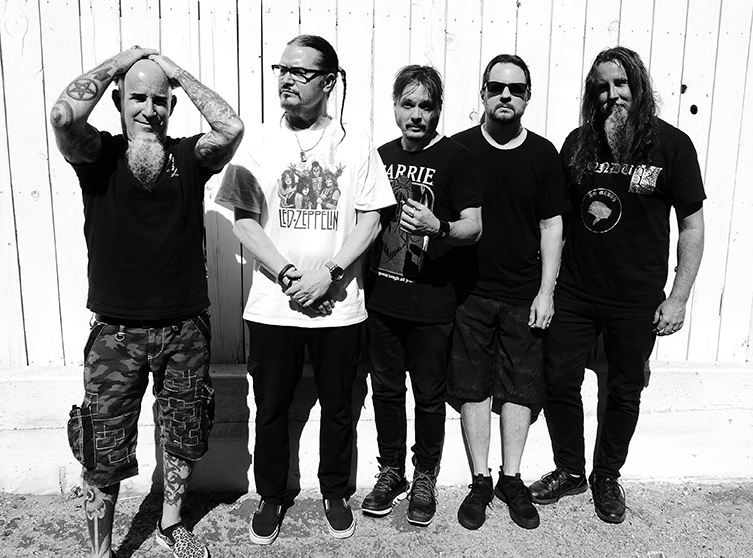
(Photo: Buzz Osborne)
A lot of people write a lot of things about Mr Bungle, and now I understand why. It’s quite a slippery task. They use so many sounds and styles within the space of a song, let alone an album, that’s it’s easiest and perhaps more appropriate to consider them in terms of an overall attitude than anything as prosaic as a genre. Contrarian? Restless? Explorative? Perverse? Silly? Maybe they are all of these things, but they are also cinematic, dynamic, relentless and hilarious in roughly equal measures.
It’s a slippery task.
That attitude is something I try to pin down with founding member Trey Spruance, guitarist in Mr Bungle and lots besides, later in this piece. He’s a skilled multi-instrumentalist who has written scores for orchestras and ballets, but is just as at home unloading riff after bludgeoning riff on Mr Bungle’s new album, The Raging Wrath of the Easter Bunny Demo.
New album? Well, kind of... it’s actually a re-recording of one of their very first recordings, a scratchy, hissy cassette from 1986. Massively heavy, unbelievably fast and blisteringly full of energy, the original tape was a potent record of a very strange and intense band. Raging Wrath was one of those recordings that was widely passed around the burgeoning Bay-area thrash scene in the mid 80s, and made opaque, underground quasi-celebrities of the mysterious people who created it. Stories about live performances with strange masks and costumes abounded, and Mr Bungle’s live shows became something of a talking point.
Without jumping too far into a history that you can readily catch up on elsewhere, Mr Bungle are nowadays hailed as extremely arty innovators who have pushed the boundaries of heavy music sideways, and often abandoned it altogether. Bands like Slipknot and Korn name them as major influences, though the three bands are nothing alike. For them to return to their very first recording, 34 years later, and remake it, is at once a most unusual move, and a very Mr Bungle thing to do. This time, though, it isn’t just original members Trey Spruance, Trevor Dunn and Mike Patton who are thrashing like it’s 1986: this time they’ve recruited no less than Slayer’s Dave Lombardo on the drums and Anthrax legend Scott Ian on guitar!
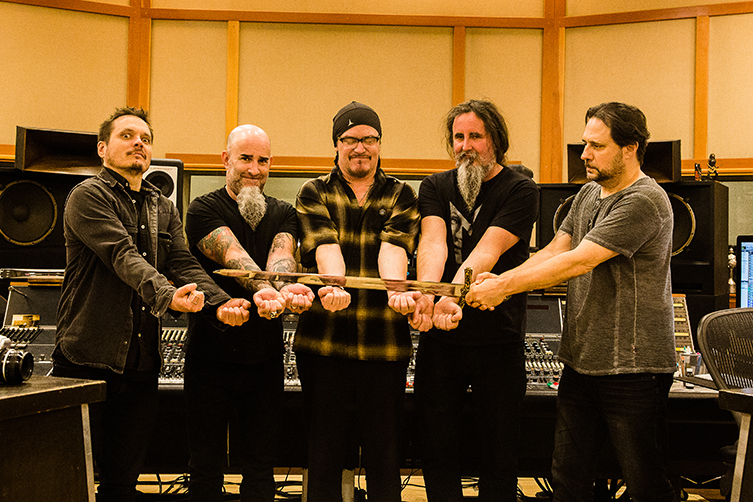
(Photo: Eric Larson)
Nobody saw that coming!
These guys, we’ll learn, were fans of the original tape and jumped at the chance to be a part of this project. For fans of extreme music, this is the type of line-up that people like to invent on internet forums. It’s Titan-stuff, and we just had to try to talk to these guys! We wanted to learn a little thing or two about not only the genesis of the project, but how it all went down, and what it felt like to be inside that wonderful, mad Bungle-world again after two decades of not playing together. How did it feel having thrash royalty play on songs written by the band as teeneage outsiders?
All Hail Scott Ian
In two separate Skype calls, I had the honour of catching up with both Scott and Trey, a week apart, to discuss all things Raging Wrath. Both men had plenty of really great, really interesting things to say, from either side of that creative equation. Rather than try to splice the pieces together, which felt somewhat contrived and phoney, I’ve elected to run the conversations one after the other, where the flow is so much more natural. We begin, as I did in real life, with Scott Ian, who was giving interviews from his home in LA. Scott was on great form and spoke in very quotable sentences! He’s a witty, pleasant guy and is lots of fun to talk to. Without further preamble, let’s get into it:

(Photo: Buzz Osborne)
Mr Bungle Interview
guitarguitar: So, I thought we could talk a little about the new Mr Bungle album, but also just chat about riffing, tone, that kind of thing, if that’s all good with you?
Scott Ian: Sure!
GG: Cool, so before we even get there, how has this year been for you generally?
SI: Good! Busy! (laughs) I think, playing in a working metal band for 39 years kinda makes you ready for anything, so shit happens, and you adapt! (laughs) You just make the best of it. I’ve been busy: I’ve been enjoying the time with my family. I’m seemingly busier than ever, so yeah, somehow it all makes sense.
GG: Not a bad way to be!
SI: Yeah!
GG: So, I guess we should start at the start with Mr Bungle: how did you get into the position of playing with them?
SI: It’s funny, I actually pulled up the text message today because I was wondering: when did Mike ask me? It was actually June 29, 2019 and you can read the text (holds up phone to computer camera). I texted him about something else and he said: “Dude, thanks man, your ears must be burning! Been talking about you the last few days. I’ve got a wild idea I’d love to ask you about, can’t recall if I’ve mentioned this to you before. Have you ever heard Mr Bungle Raging Wrath cassette from ’86? We’re considering doing it live as a left-of-centre reunion with Lombardo on drums. Might you be interested in joining us for this insane detour? You influenced that music so much that I just had to ask! Just an idea, let me know what you think! Hope you’re good, talk soon. Hugs, Mike.”
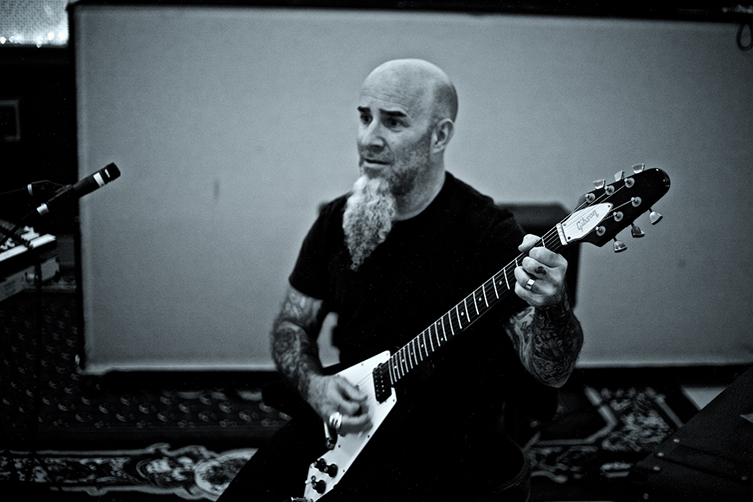
(Photo: Husty Höskulds)
GG: Wow!
SI: That’s how I got into Mr Bungle, haha!
GG: Not bad! So, you were previously friends with Mike, then?
SI: Yeah, yeah, for a long time. We actually met for the first time in ’89, when Faith No More was opening for Metallica in LA. I was at those shows. I already knew Mike Bordin (Faith No More drummer) from years before that because I met Mike at Cliff Burton’s (original Metallica bassist) funeral. So, I already knew Mike, and mike introduces me to the rest of the band. I’ve known Patton for a long time.
GG: Cool. And, so he asked you along to the gigs first of all. When you played the shows, were you aware that there was going to be recording happening in the future?
SI: Oh, yeah! Can you imagine if that was a surprise thing? (laughs) After the last show: ‘By the way, we’re going into the studio to make a record TOMORROW! It would’ve been, actually, very Mr Bungle-like if that were to happen! But no, no, right from the start, that initial text from June 29th quickly snowballed. Trevor, Trey and Mike were already thinking, ‘Well, if we can get Scott and Dave... if you keep reading those texts, you’ll see I ask if Dave’s doing it and he says, ‘Yeah, Lombardo’s already in’, so I’m like, ‘Well, Fuck! I’m in, yeah!’
"I change what I’m doing 93 times in Sudden Death. I learned that song in literally 90 second- or two-minute increments"
So as soon as they knew they had the line-up, they said, ‘Well, what would you think about recording it and giving these songs the proper representation they’ve never had all these years?’ I was like, Fuck yeah! First of all, don’t get me wrong: I love that old tape! I had a copy of it from back in ’86, but it’s kind of unlistenable. These songs need to be heard! So yeah, we knew right away that it was gonna be a combination of rehearsals, shows and then right into the studio when we were basically as tight as we could be as a band.
Riff Boot Camp
GG: Amazing! And certainly, tightness is important for all genres of metal, and you’re the Riffmaster of Anthrax so you’re one of the most celebrated rhythm guys out there, but even listening to the new record, it’s quite relentless! I’m listening to it and thinking: ‘that’s hard work, man!’ Did someone with even your skills have to just sit down and get on with the woodshedding?
SI: Dude, it was...look, I played in a metal band, I played in a thrash metal band for a long time and I’ve done things outside that which was even more intense than Anthrax, but I went back to the original Raging Wrath of the Easter Bunny demo on YouTube. My tape’s buried away in storage somewhere so I pulled it up on YouTube and listened. First of all, I was like: Well, I’m never gonna be able to learn it from here, I can’t make out a fuckin’ thing they’re doing! (laughs) But holy shit, it’s fast!

(Photo: Husty Höskulds)
So then Trevor and Trey started making demos, like proper demos, of the songs, and sending them. I was like, Wow, this is gonna be fuckin’ hard! And it wasn’t even so much the riffs because riff-wise it was, okay: this shit is really fast and I’m gonna have to build up my stamina but at least the riffs were familiar to me. Like Mike said in that initial text: you influenced this so much. And when you really dig into the riffs, you hear it: you hear S.O.D. (Stormtroopers of Death, Ian’s other thrash metal band - Ray), you hear Slayer, you hear Possessed, you hear Corrosion of Conformity, you hear all that stuff that we were listening to between ’82 and ’86. Whether it was thrash, hardcore or crossover, uh, Suicidal Tendencies D.R.I., I mean all that stuff is in there!
So, riff-wise it was familiar to me, but the arrangements were unlike anything I’ve ever dealt with before, and the intensity and the speed. I started learning that stuff probably in August of 2019, when they started sending the demos. It was a solid 5 months. I mean, I’m talking...I have never, ever, ever, woodshedded like this for anything! The level of difficulty in some of these songs, like a song like Sudden Death: that was a solid month until I really felt like I could stand in a room with those guys and feel good about myself! You know, just nailing it. That took a month. I change what I’m doing 93 times in that song!
GG: You are kidding!
SI: I sat and I counted! I change what I’m doing 93 times in Sudden Death. I learned that song in literally 90 second- or two-minute increments. I would run two minutes of it for a week and then get into the next two minutes of it. Like, yeah, around Christmas time was when I felt like ‘I’m ready’, and I still had a month before we started rehearsals to just run it and not be stopping and learning parts.
Then I just ran the shit – the whole record – twice a day for a month. Trevor and Trey came to LA first. They came to my house actually for two or three days, just the three of us, because we decided that it would be really smart to just get the guitars super-tight before we went into a room with the drums and Mike. Let’s just play real quiet, in my house – we have three little amps – and we played real quiet so we could hear every single thing we were doing. I wanted to know what parts Trey was gonna be playing and what parts I was gonna play because I was basically learning everything. We spent those three days, and I think that was just so important, because then when we walked into band rehearsal after that, I mean, the three of us were so locked. Then we only really had to worry about Dave and Mike. The three of us, we were already there.
"So yeah, it’s the hardest, as a musician, I’ve ever worked. On anything! My right arm still hurts and I actually developed arthritis in the ring finger of my left hand, just from playing so much!"
Man, I can say it’s the hardest I’ve ever worked. Whether or not it was my material! I mean, obviously writing and recording an Anthrax record, let’s say over the period of a year, is super hard work, but that’s my material, that’s stuff that I’m involved with writing. This was sheerly learning someone else’s stuff, and that adds another layer of difficulty for me. So yeah, it’s the hardest, as a musician, I’ve ever worked. On anything! My right arm still hurts and I actually developed arthritis in this joint (holds hand up to camera) on the ring finger of my left hand, just from playing so much!
GG: Oh my god! Talk about passion!
SI: I’m gonna get a little bunny tattooed right here, haha! (points to arthritic digit)

(Photo: Husty Höskulds)
Scott Ian’s Raging Wrath Arsenal
GG: Most definitely! Well, I’ve been listening to it a lot and the tightness has really paid off. It’s an incredible sounding album, it’s brutal! Congratulations on the sound! The guitars are really something on this. Were you using your signature Jackson V’s here?
SI: Yeah, yeah, of course! Yeah, it was a couple of my newer King V’s. One, specifically, I just call it my Number One: it’s the first white one they sent me. That one just sounds incredible. That was the main rhythm guitar on most of it, and then I’ve got a couple of other ones. I’ve got a natural Korina one that I used a bunch on it, and then I even brought my ’82 Randy Rhoads that was in the studio and I used that for a bunch of overdubs: lots of noisemaking, lots of whammy stuff. Yeah, it was all Jackson V’s.
GG: Sweet! I haven’t gotten to the stage where I’ve tried to jam along – wish me luck – but is it all in standard tuning?
SI: The whole thing is Eb, a half-step down.
GG: So, what’s your typical string gauge for doing that?
SI: I went back to using 9s on this, just regular old 9-42. I basically did everything I did in the 80s! The whole goal of this was, not necessarily to recreate something from 1986, but at least, you know, be faithful to the tones. Look, I’ve used the same rig forever for recording. It’s always a combination - especially since I started using the EVH heads – I use a combination of the EVH, I use one of my JCM800’s from 1982 with a TC Electronic box in front of it. It’s the same shit I’ve used forever! And it used to strictly be the Marshalls, but then the EVH, I’ve found, adds a really great low end when I combine the two half stacks together. That’s what this record is: it’s the same thing I’ve been doing forever, but the mix on this record is different, and you’ve got different players and you’ve got a different drum sound, so it brings out certain things in the guitars that maybe you’re not hearing on an Anthrax record, but it’s the same rig I used on the two last Anthrax albums. And the same guy mixing it, Jay Ruston. That’s my setup. I used 9s on it because I find the lighter strings actually just cut better. I find heavier gauge, obviously if you’re tuning low, yeah. You can’t use 9-42, but the heavier gauge changed the low end. It gets bigger, kinda fatter, less controllable and there’s something about the lighter gauge, in the 80s, that was what I used and that was my sound. There’s a great midrange in those strings and I wanted to use that. That’s definitely different, because I haven’t used 9s on an Anthrax record in forever! Its 10s or 11s always, so there’s definitely a difference there in the tone.
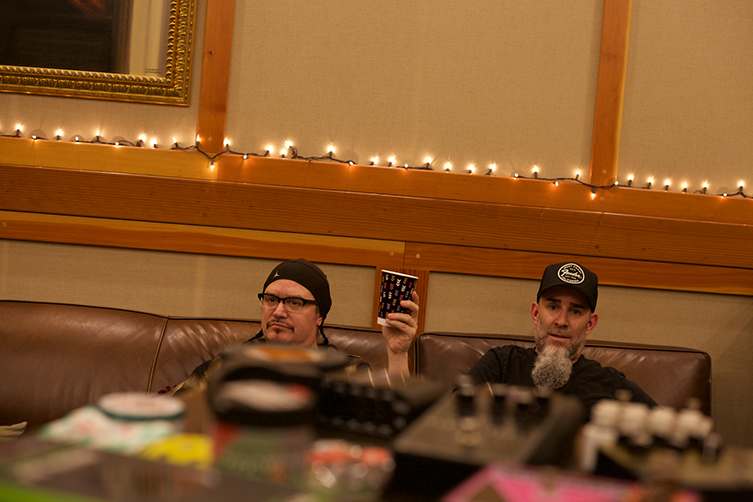
(Photo: Husty Höskulds)
GG: Yeah, and I don’t know if you’d agree with this, but I recently tried 9s again on one of my guitars and I feel like there’s a nastiness to 9s that heavier strings don’t have.
SI: Hundred percent. Yeah! I don’t know if it’s because they’re vibrating more? Part of it could be, y’know, unless you’re playing light as a feather with 9s, you’re never gonna be a hundred percent in tune. Even resting my palm on a 42, a low E, it’s gonna cause some tuning issues, and sometimes even that bit of weirdness in the tuning creates a nastiness in the tone that isn’t gonna be there if everything’s perfectly in tune. Like, if I was using 11s, I could beat the shit out of it. There’s just something about the 9s. That’s what everyone was using n the 80s. We were all tuned to standard and we were all using 9s. There’s definitely something to be said for that.
GG: For sure, for sure! So, I know that your signature Jackson has a hard tail bridge, but I’ve often seen footage of you playing with a V that has a Floyd Rose.
SI: Yeah.
GG: So, when you’re doing rhythm work, do you have to change anything about your right-hand playing position to deal with the Floyd being there? So that you don’t push your notes sharp?
SI: Nah, I don’t! I’ve been playing with a Floyd for so long. My original Rhoads has a Floyd on it, and even Charvels I had before that. I’ve been playing on that for so long. No, it doesn’t affect it at all.
GG: Cool, good to know! The other rhythm-related thing I wondered about was, in relation to the gauge 9s and your playing technique, what’s your favourite type of plectrum to use for the type of playing we’re talking about?
SI: Um, the .88’s. In the 80s, I used the Dunlop .73’s, the grey ones. Then at some point, I started using heavier picks, they started feeling a little flimsy in my hands. I don’t know if that’s just because, over the years, my hand got stronger and the lighter pick just felt flimsy in my fingers, but I’ve been using .88’s for ever. I use the D’Addario ones now and my tech scores them with a blade so I can grip them really well.
Live-Tracking
GG: Excellent! So, in terms of the recording, I assumed that, with things being how they are right now, you’d have recorded it remotely. That’s not the case, though, is it?
SI: Oh yeah, it was done in February. Right after we finished the shows. I think the last show was February 13th in San Francisco. We flew home the next day, took a day off and we were in the studio the next day making the record. It was like ten days in the studio. Mike didn’t finish all the vocals when we were at 606 (Los Angeles studio owned by Dave Grohl - Ray) doing the recording, he did a lot of vocals at this house as well. But yeah, we did it all together. Most of that record, you’re hearing us playing live in the room. We set up live, just like we did for the shows and then only went back and did the little fixes we needed to do. We really wanted to capture the energy of everything we’d been working towards for months: learning songs and then rehearsing songs and playing the songs live. We were as tight as we were gonna be in the moment, getting into the studio. So yeah, we just set up live and ripped through those songs, a couple of takes each.
GG: No way! So, what we are listening to is, fundamentally, a take of you guys playing?
SI: Yeah, most of that record is like a live record. There’s lots of overdubs and lots of other things going on but the main basic tracks? Yeah, it was the four of us in a room. And Mike singing, too! I’m sure a lot of stuff was kept.
GG: Wow!
SI: He was on a mic going nuts while we were recording.
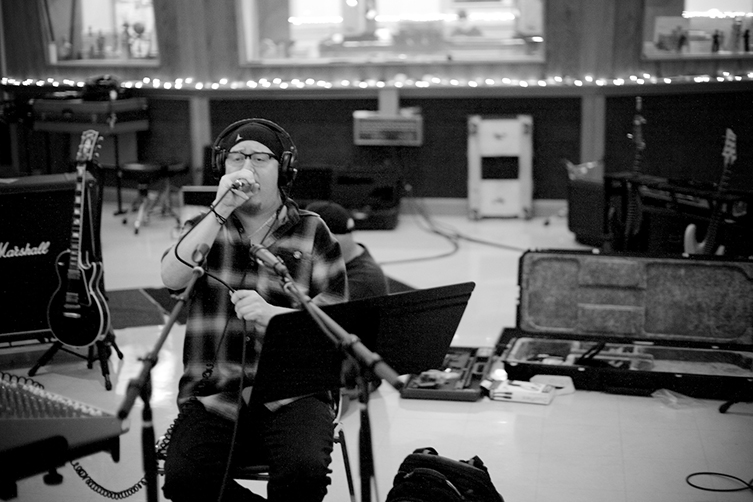
(Photo: Husty Höskulds)
GG: That’s amazing! Something as technical sounding as that record would be something I’d expect to be done individually, spending five years on every track!
SI: You know, when you work with Mike, he’s the maestro. When you’re in a room with him rehearsing for 7 days, 7 hours a day, and running stuff over and over and over again, it’s super fun and it’s super demanding. He hears everything! He’s one of those guys. When you’re working, I mean, the slightest little thing, his ears are so incredible. So when we finished rehearsal in Los Angeles, we were so tight as a band, we were so ready. And then the shows of course made us even tighter.
So yeah, it is very technical, but we were in a place where we could do it and we really wanted that vibe of us playing with Lombardo, you know? This feel of just going for it, you know?
GG: Totally, yeah. I didn’t realise that, and it makes the whole record more special, actually. In terms of working with Mike, then, if he is the maestro, as you say, does that mean he’s in charge of things? Without making him sound like a dictator, does everybody effectively answer to his vision of what the music should be like?
SI: I can’t say that, because obviously I wasn’t there in ’86, but no. I think it’s very... it was so democratic that Dave and I even had a say. You know, they would constantly be asking us what we thought, and I’d be like, ‘You made lots of right decisions as far as I’m concerned! You don’t need my opinion on this, you know what’s right for this! It’s your music, it’s your songs!’ Of course, I always appreciate them asking me what I thought, and I’d always weigh in with an opinion, but I was like, I’ve been a fan of Mr Bungle since this tape came out, so whatever we’re doing, I’m good with! But it was between Mike, Trey and Trevor. Mike is the frontman, and it’s just kinda his, certainly the scenario and the position that he’s built on and earned over his decades and decades as a guy doing so many different types of music and projects. And he just has that ear. When you are just ripping through a song and you’d be headbanging, all of a sudden, he’d be like, ‘Stop! We need to work on that. That transition there needs to be better’. It’s not like a dictator kind of thing, it’s just making sure that the song is going to be the best it can be. And I appreciate that so much.
GG: It’s like that’s just one of his skills: having the ability to do that. Everybody realises it’s for the best.
SI: Yeah, he’s truly a conductor, in every sense of the word. And he wrote a lot of the material too. A lot of the Bungle material, he wrote on a guitar he had in his house, some shitty guitar that literally had one string on it! He’d play with one finger and come up with these riffs, and Trey and Trevor would have to, like, transpose that into an actual guitar riff. They kinda learned how to transpose these kind of insane Mike Patton parts from one finger on a string! (laughs)
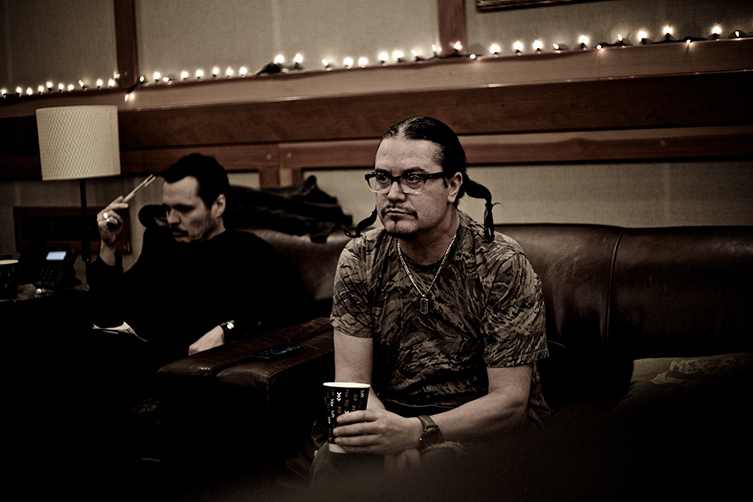
(Photo: Husty Höskulds)
GG: Haha, nice! In terms of the playing on the record, is it one of those deals where you are panned over to one side and Trey is on the other?
SI: Yeah, I think if you’re listening to it, I’m on the right, I think! Put it this way: I start Anarchy up Your Anus, so when that first heavy riff comes in after Grizzly Adams, that’s me. So, whatever side that is, (laughs) I’m that side for the whole record. There are times in the mix when we did different things, where the whole thing becomes mono sometimes, just for different sounds and different effects. Or maybe a riff might start in the centre, depending on whether it’s me or Trey introducing a part, but in general, yeah, it’s pretty much hard left and hard right.
GG: Cool! And there’s quite a lot of high-register texture guitar parts, too. Like, noises and wails. Is that a mix of both you and Trey?
SI: Yeah, that’s both of us. I think a lot of it is stuff that Trey had done, as well as stuff that he had planned on doing. Then for me, it was usually a case of, I’d be sitting around between something going on, doing rhythm guitar fixes or whatever. I’d just start making some noise and Mike would be like (points finger dramatically), ‘Do that! Do that right there! Let’s put that over this part.’ He just loves sound, and so do I, so there are so many times where I just got to make all these crazy noises. That whole outro of Methematics, where we’re looping that riff and you can hear these high, weird sounds? That was me just picking the strings above the locks on the headstock, through this crazy...I forget which pedal it was, an EarthQuaker I think but I don’t remember the name. It was just making this insane noise that was kind of flipping back on itself. I started doing that, just goofing around, and he was like, ‘Do that, do that! Just put it through the whole part!’
GG: Oh cool!
SI: Yeah man, any time I could make weird noises, I’m in! (laughs)
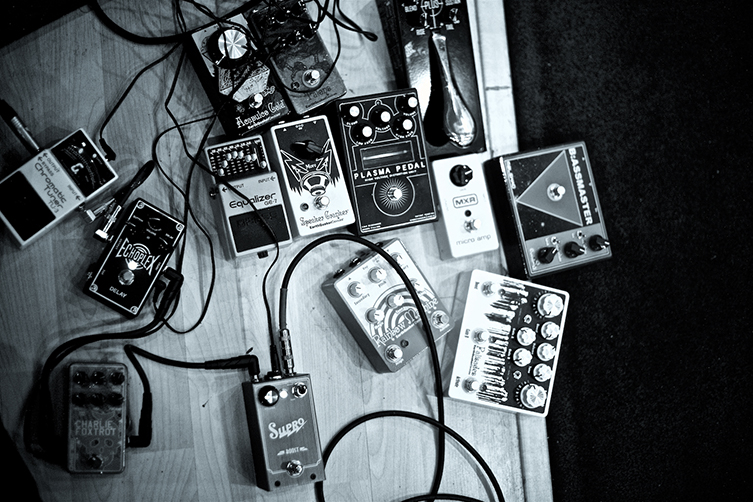
(Photo: Husty Höskulds)
GG: Haha, definitely! So, in terms of Mr Bungle, is the idea that, when touring is a possible thing for musicians to do again, will you be playing more gigs as part of Mr Bungle?
SI: Yeah, the original plan was to be playing shows now! We would’ve been out touring for the record release. Of course, that all changed, but yeah, that is definitely the plan. As soon as there’s a window where we can safely say ‘We can book shows’, haha! Yes, we plan on playing shows at some point.
GG: Wicked! Okay, and for a final ‘what else is going on’ kind of question, are you working on new stuff for Anthrax?
SI: The original plan was to have an album out for next year, because it’s the 40th anniversary of the band next year.
GG: Oh, wow! I didn’t realise.
SI: But, uh, we just don’t know! We’ve got a lot of an album written, we’ve got a lot of arrangements, and we have a lot of great ideas. It’s just a case of when we could actually get together, and travel and be in a room. Everything we do is at the mercy of what happens with Covid, when it becomes safe to, you know, act like things are normal again! (laughs) So, I don’t know. Eventually, we’ll get a record done! Eventually, we’ll get back out and tour. I would assume, even with a vaccine, things are still going to take a while to get back to actual normal. Is it gonna be next year? I dunno. Is it gonna be 2022? I hope so! (laughs)
Scott Ian on Riffs
GG: Yeah, me too! Well, I guess I’ve got one last thing to ask you, before we say goodbye, if that’s okay? It’s about riffs. Would you say that the best guitar riffs are where you feel them and they just kind of happen, or would you say that the best ones are written out in advance?
SI: Um, its both! You know? I don’t know! (laughs) It’s both. Sometimes, things come really easy, and sometimes they take a year till you’re able to figure it out. It’s hard to say! The best riff I ever wrote, in my opinion, is the March of the S.O.D. riff and it’s one of the most caveman riffs ever written! But as far as heavy riffs go, I think it’s the heaviest thing I’ve ever written and it’s the simplest, and it happened in about 4 seconds.
GG: Right!
SI: I dunno if that answers your question? (laughs) I also wrote the Wardance riff for Indians, that section, which I think is also an awesomely heavy, brutal part but that was way more thought out, and I actually spent time on that. That riff went through a few different configurations, and a whole process of figuring out what that riff was gonna be. And it also came out great, so it can be both.
GG: There are no rules: the riff is either good or it’s not.
SI: Yeah!
With that, we bid Scott farewell. He gave us loads, and it’s a privilege for any guitar fans to spend some talk-time with someone so experienced and enthusiastic.
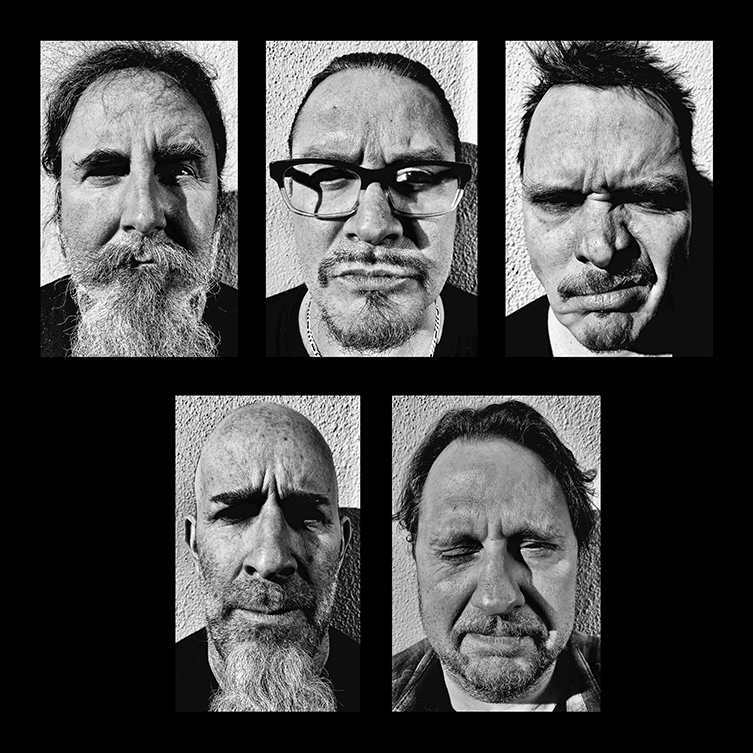
(Photo: Buzz Osborne)
Trey Spruance
We joined Trey from his home in Arizona, where he had just recently moved, escaping both the Covid mass-exodus from San Francisco and the terrible wildfires affecting California. ‘It was dramatic’, he says, as we chat about moving properties amidst a pandemic. “It’s been a dramatic year. I definitely have not been bored! I’ve been waiting for the time to be introspective, as normal, but I don’t have any time to be introspective or get bored, haha. It’s fucked up!”
Indeed. But it’s been a very creative one too, and Trey was, as you’ll read, extremely generous with not only his advice, but also his methodology and reasoning behind why he does what he does. There’s also a little bonus anecdote at the end for hardcore Bungle fans, but before we get to that, here’s what Trey had to say about returning to The Raging Wrath of the Easter Bunny.
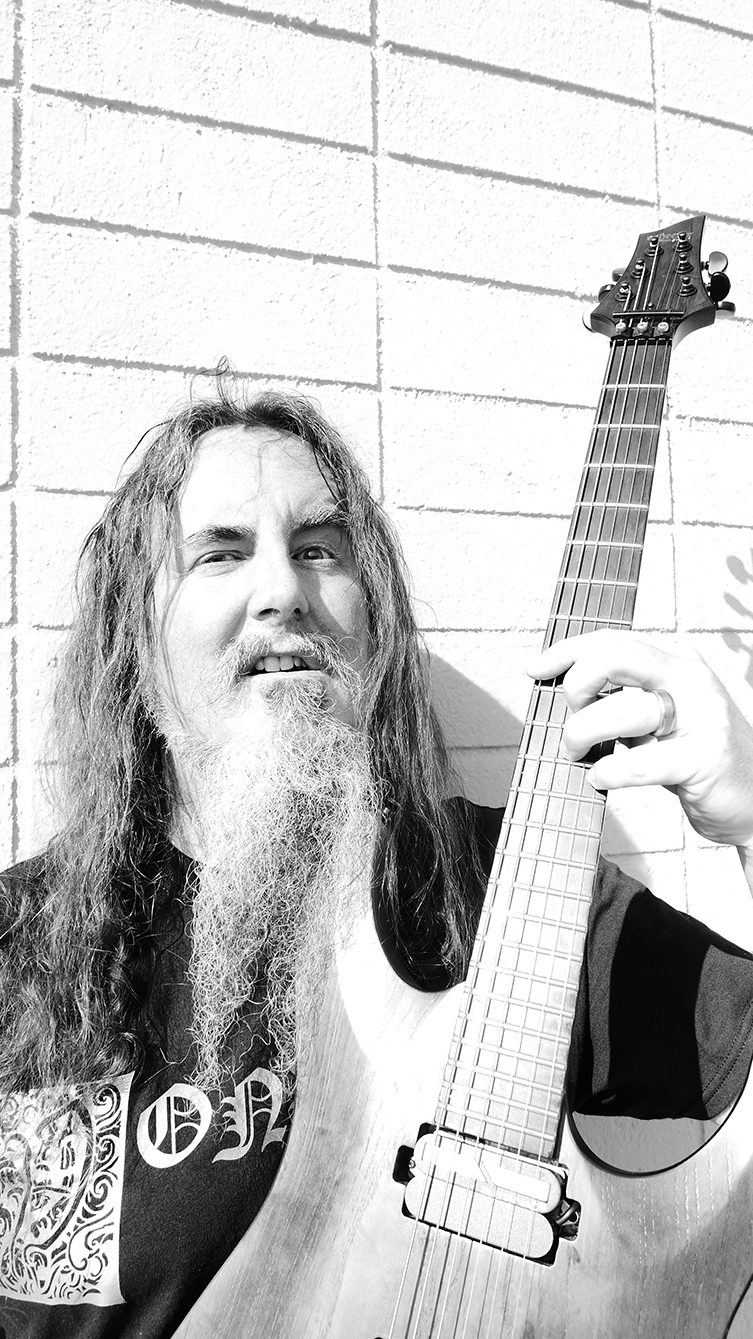
(Photo: Buzz Osborne)
guitarguitar: So yeah, I guess the first obvious question is: what was the motivation to go back to your earliest work and re-do it?
Trey Spruance: I mean, just that it had never been...it’s music that’s very dear to us - to Trevor and Mike and myself – and to our friendship, but it has never been represented well, or faithfully. We felt it was significant because it was this thrash metal music in 1985, right when Reign in Blood by Slayer was happening, right when S.O.D. was happening. It fit right in with all that stuff, but nobody knew that that was our beginning. It kind of felt like: sharing this with the world would be interesting, you know? It would be a good step for us.
GG: Yeah, I must admit I’ve listened to Mr Bungle for quite a long time – I got into it with California – so if you let someone hear that record and then you put on the Raging Wrath of the Easter Bunny, it’s almost like two entirely separate bands! Most bands don’t have that wideness of some breadth, do they?
TS: Yeah, that’s for sure! It’s interesting that we’re talking for a guitar site, because one thing that California isn’t, and y’know, I’m a guitar player, but California and Disco Volante both represent my journey away from the guitar. Like, I stopped thinking about guitar, I think, in about 1989 or so, to focus more on music theory, production, arrangement and orchestration, this kind of stuff. Around the mid 90s I started getting into, you know, non-Western tonalities and stuff like that, so I was getting further and further away from the instrument of the guitar. But of course, it’s like my baton for conducting in a way: I’m still involved in the ensemble because I have a guitar in my hands.
The Wrath of the Easter Bunny is like a straight return to guitar, like, that guitar music, 100 fuckin’ percent guitar music!

(Photo: Husty Höskulds)
GG: Oh yeah!
TS: It was like, Oh, shit, we’re doing this? I have to be a guitar player again? Oh, okay! (laughs)
GG: Haha, totally! You’re actually touching on so many questions that I want to go deeper with, so I’m gonna try to make some sort of corral myself as I go along...
TS: Yeah, there’s a lot of ground to cover, I know!
GG: Haha! Well one of them, I suppose, is... I spoke to Scott last week about it, and he was saying that learning the material was the hardest amount of woodshedding he’d ever done in his life, and I can believe it from listening to it! He made the point of saying: it’s one thing to learn the riffs, but it’s another to play that all of those riffs in songs that have 93 changes in them, and then to keep that up for an entire record! Given that you’ve been away from the guitar and then come back for this material which you wrote when you were 18 or 17, did you have to just sit down with your guitar and go: ‘Holy shit, I need to practice!’
TS: Yeah, I was 15! (laughs) 15, in August 1985. No, 16: we started the band when I was 15 and I was 16 when we did the recording. But yeah, so you’re different when you’re 16 and you’ve been sitting in your bedroom practising the time. It’s something I haven’t done since I was 16!
GG: Sure!
TS: Scott, at least, has been playing fuckin’ metal the whole time! (laughs) He has that advantage over me! But the advantage I maybe had over him is that this music is burnt permanently into all of our minds, so, like, I didn’t have any problem remembering 96 riffs in a chain or whatever. But, except for the early shows when I was 16, I had never played all of that music back-to-back before. So, the question of stamina comes in, you know?
GG: Definitely.
TS: I learned, when I played a show with Faith No More in Chile, again, I toured like 600 shows with the Secret Chiefs in the last ten years or so, so I know what it is to play a show, but it’s a different thing when you stand up there with a wall of amps that you’ve never ever seen before, and like 80,000 people, and the monitors are 40 yards away. The nearest band member is 30 feet away... it’s different! And their guitar player, Jon Hudson, really helped prepare me for that transition.
I learned a lot from that, like: okay, you think you can play guitar, but can you play guitar in this situation? And they’re very different situations. Well, can you play guitar in a speed-death-metal band for an hour and twenty minutes, going at fuckin’ 200bpm – 260 at some points! – speed picking all the time, transitioning between all of these insane riffs and then going, ‘Okay, now I’m gonna play a solo’ (laughs)... that was all new so yeah, I picked up practising again! I had to, man, because it was hard!
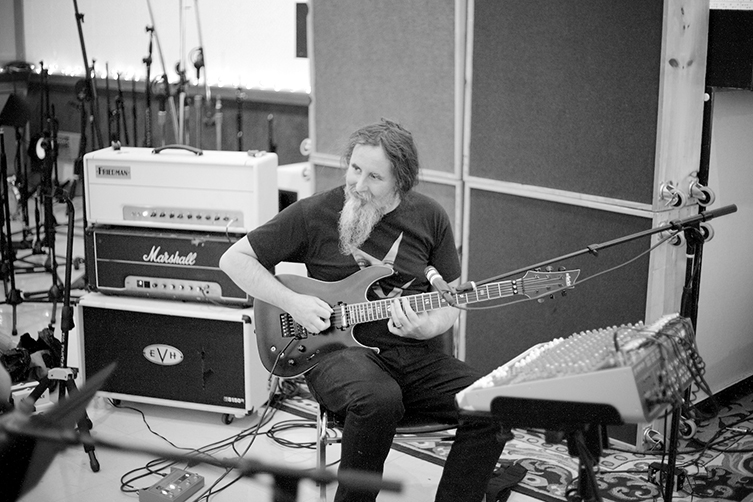
(Photo: Husty Höskulds)
We’ll get into gear questions, but I didn’t have any good instruments: the guitar is something I’ve neglected terribly. I had to buy something that would be appropriate for this music, so I bought a Schecter and that changed everything! Suddenly it was like, oh, okay, I can practise! This is easier than I thought it was gonna be! It was more fun than anything, but I took it real seriously: I practised every bit as much as Scott did.
GG: I think it’s always good to know, when one listens to such technical music, that it doesn’t just fly effortlessly from even the creators themselves. You can think that stuff but getting your fingers to follow your brain with these ideas is not a given! A lot of it must just be sitting down with the metronome, right?
TS: You know, it’s funny you say that: it’s one thing to sit down and hit the record button and go: here’s this riff – stop – now, here’s this riff – record button...It’s a different thing to stand up, right? It’s a completely different position. Your picking hand is in a different place, and everything’s different. So, no, you have to stand up! Like, I found it was really traumatic to sit down all the time. For your physical presentation, you have to stand up. You’re not gonna sit down at the fuckin’ gig! That matters, and in metal, speed-picking and shit: that really matters.
GG: That’s such a good point actually: strumming and palm-muting, for example, require almost entirely different body language just to allow your wrist to work at the correct angle. The guitar ends up playing you in that situation, and you have to kind of adapt a bit, don’t you?
"I found it was really traumatic to sit down all the time. For your physical presentation, you have to stand up. You’re not gonna sit down at the gig!"
TS: Absolutely, and even things like: are you gonna hold the pick straight? Or are you gonna hold it at an angle? When you’re going at 250bpm, playing, whatever, 32nd notes. I had to make a decision when I was practising: am I going to pick across the string, flat, or am I going to do diagonal? This is tricky, because for solos, diagonal picking is better in a way, because you don’t have to dig the pick in so far and you can just go more quickly. But for riffs, it just doesn’t feel good to be hindered that way and not be chugging, like, hitting it hard. I had to figure out: am I going to self-consciously switch picking positions, or am I going to just feel it? I taught myself to pick all over again, diagonally, because I never worried about that kind of shit before! I watched our pay-per-view thing (Mr Bungle’s Halloween show - Ray) a little while ago and noticed that I was doing it without thinking about it, changing my hand positions.
GG: Cool, so it became second nature, nice! Well, we’ve mentioned Schecters, so why don’t we talk about the gear?
TS: Sure.
Mr Bungle Gear
GG: Since we’re on the subject of plectrums, I was surprised to hear that Scott uses a relatively light pick, or at least he used to: a .73mm during the 1980s and a .88mm nowadays. That was all on gauge 9 strings for this recording. I wondered what your situation was?
TS: It’s funny: I’m the opposite. I like heavier picks. Not all the way to jazz-heavy, but the .88s are just a little thin for me. The guy from Dunlop gave me a whole bunch of different picks and I score them with a razorblade to make a grip out of them.
For strings, I use uh, 56 to 10s or 11s. I had to figure out this thing, because we are downtuned one half-step for this whole record. I’m used to playing instruments that have a lot of range, so I had to conform to regular, standard guitar sets a little bit, because setting up a Floyd Rose is not a fun thing (laughs). You have to stick with a normal thing, so I think I ended up with 56 to 10 or 11. For metal, I don’t want to bend the strings a whole lot, especially with a whammy bar, it’s like ‘what the hell’?
GG: Yeah, exactly.
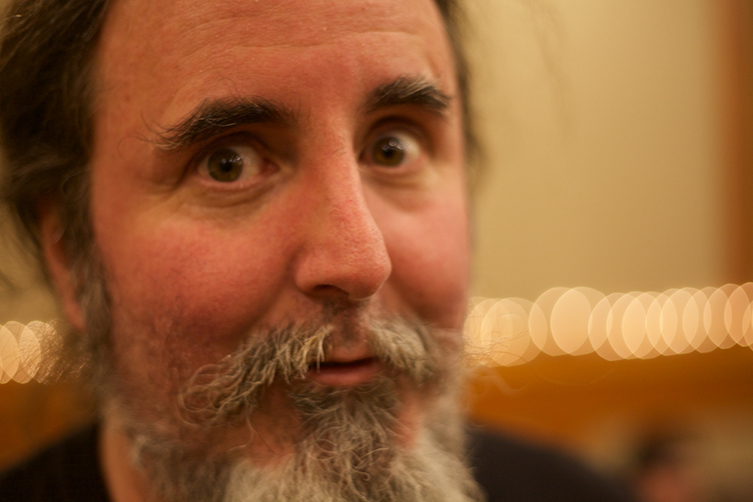
(Photo: Husty Höskulds)
TS: Thicker strings, for me, are better for the shredding. Although that doesn’t make sense in a way, because I know that Eddie Van Halen used really thin strings and there’s a whole school of shredding from him.
GG: It’s true, but you know, Eddie Van Halen also used a .60mm plectrum, and not only that, he held them in between his thumb and middle finger, so he could tap with his index finger. So, rules are out the door with that guy! Whatever works is good, you know?
TS: I’ll tell you something: on the original tape - I was an Eddie Van Halen fuckin’ fiend back in the 80s – and that’s how I held the pick! I learned how to do that harmonic shit from him, and pretty much my whole life I’ve been doing that. I had to re-learn holding a pick for this gig! (laughs) He’s a finesse player, and if I was playing finesse, I would certainly revert to that way of holding a pick.
GG: Ok, cool, that’s interesting! Eddie’s influence looms large! Before we get to your guitar playing, what about amps? The crunch is amazing, and Scott said he was using his 5150s and his Marshall.
TS: Yeah, I think he was favouring his Marshall, actually. For me, when we were in...what’s the name of that studio? (laughs) It’s a number...
GG: 606 Studios?
TS: 606, that’s it, yeah. They have an embarrassment of riches in the amp department, so there was really no point in me bringing any. I don’t even own anything suitable for metal at all! In fact, the only amp I have right now is a Rivera, which is for a totally different kind of music! (laughs) But, man oh man, that had some great stuff! So, I ended up just bi-amping with some kind of hot-wired Friedman that looked like a JCM900. I don’t remember exactly what it was, but it was so overdriven it was almost like fuzz! It was crazy! It had almost no low-end, so we put a Soldano in the chain, so it’s kinda bi-amped between a Soldano and a Friedman. We used the Soldano cabinet sound for the beef. I think the Friedman was cool because it’s just that instant articulation. It kinda gave it a little more harmonic richness. That was a good combination, I thought.

(Photo: Husty Höskulds)
GG: That sounds great, and the resulting tones speak for themselves!
TS: I was also dialling it against Scott’s sound, too. I often overdub myself twice with heavy guitars, with two contrasting tones. I was lucky because I could go into the studio and hear what his tone was gonna be, and if I’d hear a little bit of the mid scoop, I’d be like, ‘Okay, I’ll do the opposite and put some of the mids back in there’. I was kinda designing it based on his tone.
GG: Good idea. In terms of the playing, my knowledge of the 2020 Raging Wrath is better than the 1986 tape, but it seems that the riffs are mostly the same, like Bungle Grind etc, so you haven’t felt the need to change them much. I guess my question is, are riffs something you just feel, or are they premeditated in terms of selecting time signatures, scales and so on?
TS: I think it was just sitting there and coming up with stuff as a creative musician, and then things would stick. I remember I had a little ghetto blaster and I’d tape them. You know, when you’re coming up with ideas, you lose a lot of them, so having that little tape recorder was good. A song like Bungle Grind, it’s a lot of things that you wouldn’t normally come up with, I think, and that happened because I had some theme in my mind, I was doing variations on it and I would just record them all. I think my initial intent was ‘this is gonna be one riff, which one is the best one?’ (laughs) and then somewhere along the line I realised I could build a piece based in this idea.
But that’s just that song. Trevor wrote Spreading the Thighs of Death and Raping Your Mind and those two songs just have, to me, they have those classic Thrash Metal riffs in them that are worthy of Exodus, or The Possessed, or any of the bands that were going at the time. So, our approaches also were different: his songs were like the classic riff and then there’d be material that navigates between those classic riffs, whereas I think my writing is more developmental. Like Grizzly Adams, you know? That’s also the developing of a simple idea, but it gets weirder!
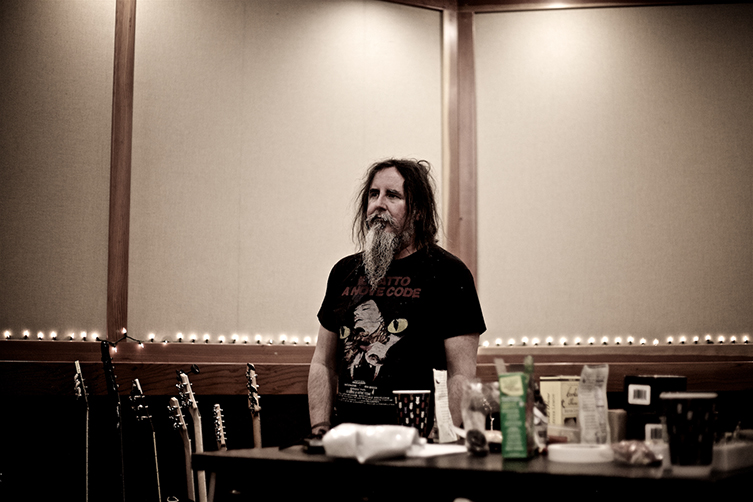
(Photo: Husty Höskulds)
GG: Haha, yeah, I’m with you, totally!
TS: Let me tell you one more thing: Anarchy Up Your Anus was written by Danny - the drummer - and myself. We had a stupid improvisation thing that we would do where we would hit the record button, and the first take – cuz he and I had this kinda psychic thing where we would stop and start together, making up stuff, pulling it out of our ass – and so we would just hit the record button, hit stop and then do it again, like 15 times. Then the rule was, you’d go back and overdub a bass part without listening to the first thing we did, I‘d just have to try to remember (laughs)! Then we’d go back and do the lyrics, first take and that’s it.
GG: Wow!
TS: That’s what Anarchy Up Your Anus was! Just pulled straight out of our asses, improvising! There was no writing process at all!
GG: That’s so good, I can’t wait to put that in the interview!
The Genesis of Ideas and Attitude
GG: So, let’s piece some other bits from my question sheet together. Something I wanted to ask you is about ideas. Now, ideas have to come from somewhere. It’s not so much the sound of Mr Bungle I’m referring to, since we’ve already covered how different the band sounds from record to record, but there’s an attitude there for sure. There’s a vibe, a creative point of view that’s very singular: you can tell a Mr Bungle tune pretty quickly, whether it’s from California, Disco Volante or whatever. I wondered, A): whether you have any idea where that comes from, and B): whether Eureka, California, where you guys grew up, played a part in that attitude?
TS: I think that’s a really fair, good question. Yeah, our friendships and our musical identities were forged in Eureka, it’s true. It also endured well past, when we moved out of there. I think what it is, is that I guess partially because those musical relationships were forged in that place, uh, certain things just make sense to all of us. Even though we are different and have very different approaches – still – where we all meet is in that place called Mr Bungle! That makes sense all the way, just completely unto itself. Individually, you’re going to hear very different things from us, but we definitely know how to ‘become’ Mr Bungle.
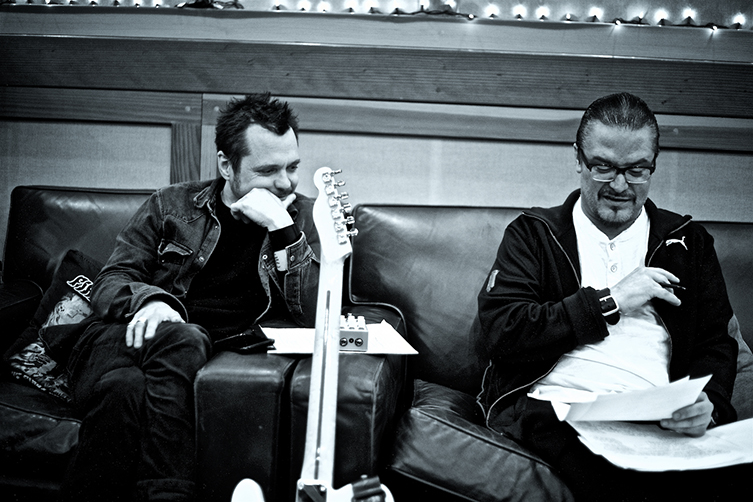
(Photo: Husty Höskulds)
It’s not even that we put on writing hats, I think that when we would write our separate music - I know for myself - I would know, ‘okay, this is Mr Bungle stuff’, like, instantly. And then, once it’s in that Mr Bungle zone, it has its own logic, and it’s gonna go...somewhere that is a collective identity. It really is a collective, in that sense. Even if somebody writes a whole song, in the end it’s everybody’s voices being involved. There are ideas for instrumentation, and these ideas that make it in all make it what it is. It’s like Bungle-logic. I’ve never ever seen any other band work the way Mr Bungle works. It’s its own thing, that’s for sure.
"What happened was, that energy just took over and it never let us down. All of us had our own ‘Holy Shit, this is happening!’ moments, which is great."
GG: Hahaha! Bearing that in mind, then, as an original founding member who is going back to earlier work that you were significantly involved in writing, how has it been with Dave Lombardo and Scott Ian coming into the mix? It’s one thing to have them in the band, but they’re playing your stuff! What’s your take on that? What do they bring?
TS: Yeah, that’s another great thing. I wasn’t sure, I mean I knew Dave pretty well, I’ve played with him - again, this is in other contexts – I’ve played with him in John Zorn improvisational stuff and Masada/Klezmer things, so very different from playing Mr Bungle and very different than playing thrash metal with Dave fucking Lombardo, right? (laughs) That’s what you grow up dreaming to do!
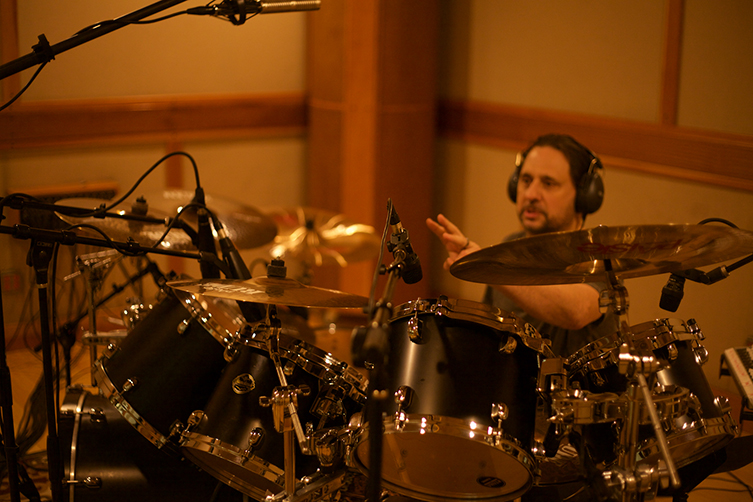
(Photo: Husty Höskulds)
GG: Totally.
TS: So, I was excited about that. But again, you don’t know what the chemistry’s gonna be and especially with Scott: Mike knew him a little bit, but I didn’t know him at all. Of course, we admire and look up to him, it’s like a dream, again, but you don’t know if the chemistry’s gonna be right. I was so pleasantly surprised; I have to say. As soon as we were together playing the music, it was like...I mean, Trevor and Mike and I hadn’t played together as Mr Bungle for twenty fucking years either! I mean, that’s a long time! So, we’re putting all of this together at this same time, and in other words, the point I’m making is, it’s not like we’re used to being this Mr Bungle reunion thing. We’re not! At all! It’s all a new thing for all of us.
GG: Sure.
TS: The excitement about that, which we had, matched the excitement that Scott and Dave had about, you know, ‘we’re gonna play this fuckin’ music! We’re gonna play this Mr Bungle shit, I can do it!’ So, they’re excited that way, and we’re excited like, ‘Holy Shit, we’re doing this? With THEM? What the fuck?!’ (laughs) What happened was, that energy just took over and it never let us down. All of us had our own ‘Holy Shit, this is happening!’ moments, which is great. Nobody stopped to think about whether it was working, or is this right or is there bad chemistry... it was instant.
GG: The planets aligned for you and you didn’t have to think about it. That’s a great sign.
TS: I think it’s because we all had that 1985/86 thing in common. We were total fucking metalheads, so in that sense, everything balanced pretty perfectly.
GG: That’s amazing! One thing which I didn’t learn until I spoke to Scott last week, which really surprised me, is that a lot of the fundamental tracks from the record are live takes! That’s really impressive! How did you find the experience of doing it that way?
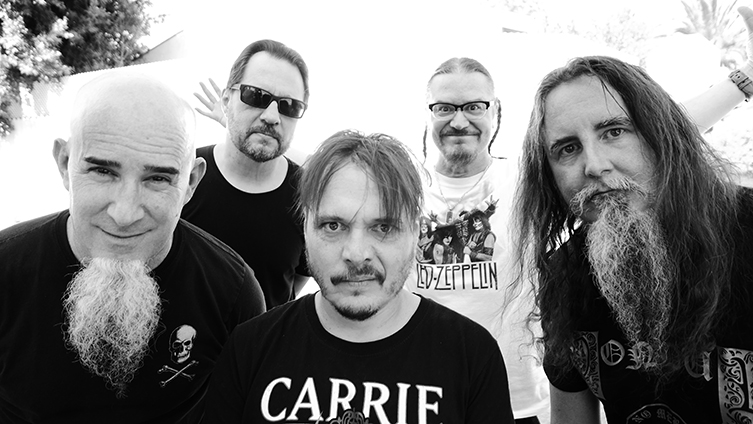
(Photo: Buzz Osborne)
TS: In a way, it’s the only way to go with that kind of music, I feel. Metal has changed: they don’t do things that way anymore. I like the way that some of that metals sounds, that approach: some of the results are really cool. But if you listen to Reign in Blood, you can tell that nobody sat there punching-in a million times. Everything is pre-production: this is a band who rehearsed and knew what they were doing. The producer knew exactly when to bring them into the studio and go, ‘record’. And to hire the right engineer – who is Andy Wallace – who can capture the sound of this band, which is ferocious at this moment, and that’s it!
GG: Uh-huh.
TS: That’s what we wanted to do. That’s why we decided to do those shows before recording. In a way, those shows were our rehearsal. Rehearsal is one thing: staring at guys in a room, all getting along and having fun. But standing on stage and fucking doing the shows...if you come off of that and hit the ‘record’ button on that energy, that’s the golden moment, and it sure turned out to be.
Seriously, we were in a room, all of us together, playing and what you’re trying to do is get the drum takes. You’re hoping that your guitar takes and your bass takes are right. And what ended up happening was that the guitar and bass, all the way around, was fine. We went back and did punch-ins there and then if there was a stupid mistake or whatever, just like working with tape. We’re trying to do this mid-80s thrash thing and that was all with tape, so the approach was like it was all tape. It turned out that we had done the pre-production right: we were well-rehearsed, and then being in the room together was just right.
GG: What a difference it makes, listening to it! You know, I can sit down at my computer and program a half-way decent version of a Lombardo-style drum pattern, but it’s not Dave Lombardo and it’s not a live performance. On top of that, there isn’t that extra chemical of a group of musicians who’ve practised their asses off. So, these factors are significant!
New Approaches to Lead Guitar
GG: Moving onto lead guitar stuff then, there’s some really interesting stuff going on there. Tracks like Spreading the Thighs of Death displays lots of skill and personality. I’d love to hear your take on lead guitar, because it seems to me that you really know your musical theory, but you love to make a bit of a racket, to be quite wild, at the same time! Would that kind of encapsulate your attitude?
TS: That’s 100%! That’s exactly how I’d say it, yes. (laughs)
GG: Are your lead parts improvised, written, or a bit of both?
TS: Put it this way, the music theory stuff is not there to demonstrate ‘Oh, I have this mastery of fucking music theory’. The point of it is to take things to the next level, to go beyond limitations. It’s really easy to have limitations on the guitar and to get stuck doing the same thing over and over again. This is where music theory ideas, ideas that come from studying music theory, can be very helpful. Like, Spreading the Thighs of Death: the riff itself behind the guitar solo could be interpreted a lot of ways, but I listened to it and said: ‘Well, this is a Whole Tone scale, that I knew from Debussy, and I thought, okay, let’s do Whole Tone some of the time and then do divebombs and kinda go into more recognisable scalar stuff. So, I end up blocking solos: like, from here to here, I’m gonna do some fucking crazy Whole Tone run; from here to here, I’m gonna do some wailing divebombing stuff; here I’ll do some harmonic thing. So, I’ll organise the solos into a series of events where I don’t know exactly what I’m going to play but I know what musical theory grid I’m going to put over the top of it.
"Put it this way, the music theory stuff is not there to demonstrate ‘Oh, I have this mastery of fucking music theory’. The point of it is to take things to the next level, to go beyond limitations"
GG: Yeah, almost like you’re telling a story and you don’t know quite what vocabulary you’re going to use, but you know where you have to start, and then the point of the story and the end of the story.
TS: Yeah, exactly! Yeah. When we played for the pay-per-view, I was like, okay, I remembered the blocking that I had done, and I felt like I didn’t improvise as much because we had made the recording and I’d listened to the recording. It ruined my sense of spontaneity, you know? (laughs) So, I gotta get that back somehow!
GG: Fair enough, man! Now, your guitar playing’s technically very good, and you also have a very unique voice on the guitar, so I wondered if you might have any tips you can share with our readers to help them play a little more outside the box, or away from generic scales?
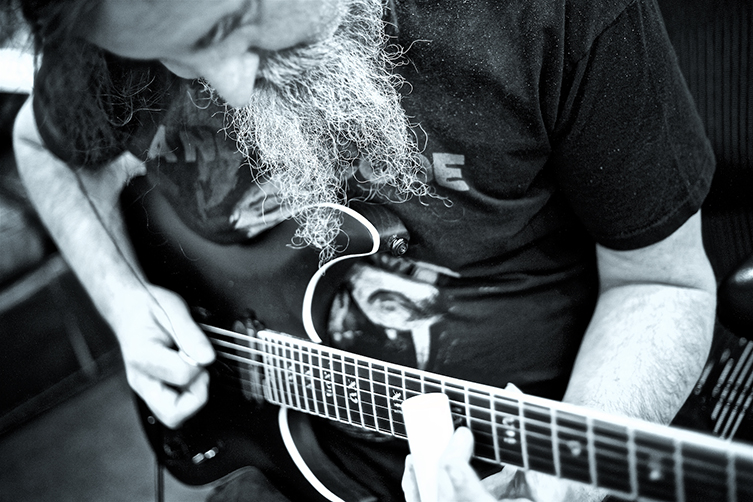
(Photo: Husty Höskulds)
TS: Yeah! I’ve said this before, and I think it sounds more complicated than it is, so I’m gonna try to say it in a way that makes it easy to relate to. One thing that I know Coltrane used to do, and he did a lot of things, but this one sort of rudimentary thing was: there was a guy called Nicolas Slonimsky who made an encyclopaedia. He called it a Thesaurus of Melodic Scales and Patterns. You asked me about thinking outside the scale box. This is the way to do it. You look at his Thesaurus: if you play through it, even just playing the first few patterns in each category, and you start thinking in terms of intervals, like, up a 6th, down a 3rd, up a 2nd, and then move up a maj 3rd and do that same thing, and then move up a maj 3rd and do that same thing, you get these patterns. And it gets you off this thing of, ‘well, the guitar’s tuned in 4ths, and here’s a scale’. You’re going to start thinking in terms of melodic patterns and how to apply them on the fretboard.
Everything changes from the G string to the B string, and you have to be coherent if you’re going outside the box: you can’t let that transition between the B string and the G string dominate your playing. So, you just have to get these weird patterns under your fingers, and you start to realise that these patterns make their own harmonic sense. And then you start making up your own. What ends up happening is, you start to get this facility in playing melodic patterns, that make sense to a listener, that could become completely unmoored from the chord changes as they’re going by.
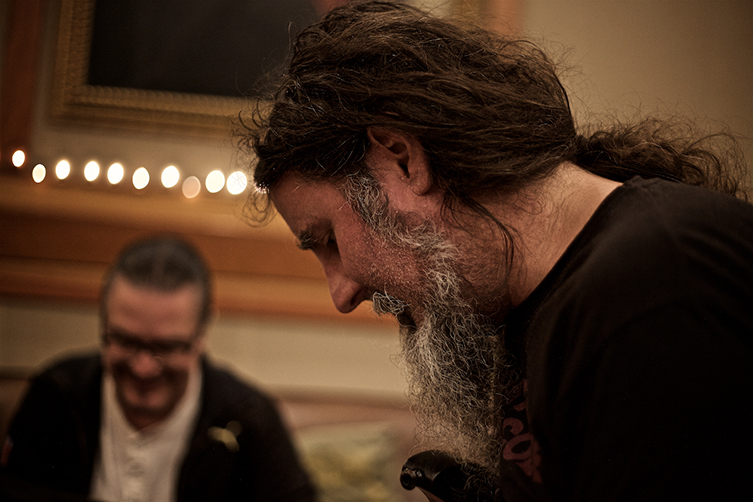
(Photo: Husty Höskulds)
Coltrane would be playing something that would be inside the chord changes, and then do maybe a similar rhythmic or melodic thing, but apply this logic of playing the note patterns and distributing them over an intervallic sequence, and then coming back in and playing inside. That is the shit! That will get you out of the box! It takes some work, you have to be serious about it and everything, but it changes everything, because after a while you can elect to be with the music that’s behind it and then you can elect to go outside of it. Then you can let your melodic sense take over again, that’s what improvisation is. Let the spirit take over. Learning to play over chord changes, and then learn to play melodic patterns without chord changes that still make sense: you do both, you’ve got something.
GG: Oh, totally! That’s probably the best response to that question I’ve ever had! (laughs) Thank you very much!
TS: I like to spread the Slonimsky thing wherever I can, because it’s within reach, you know? It’s something that people should be thinking about.
GG: You can be sure than I’m going to get my copy ordered after we’re done talking, haha! Now, given that you were supposed to be touring the record right now, and Covid has dictated otherwise, have you been working on any other interesting musical projects instead?
TS: Yeah, right now I’m working on a piece for a ballet company in San Francisco called Lines Ballet. I wrote a piece for the Kronos Quartet back in 2018 and they used one of those pieces in one of their performances, so they asked me to compose something for them. That also got shut down by the Covid, but in the meantime I’ve been thinking about the stuff, changing a lot and honing the idea more. Just a month and a half ago, they got in touch and it’s back on again. The choreographer’s Alonzo King and it’ll hopefully happen soon.
The Story of the Secret Song
GG: Amazing! Now, before I ask you my last question, there’s just one random Mr Bungle thing that, since I have you, I may as well ask: on Disco Volante, there’s a ‘secret song’ just after Carry Stress in the Jaw, and there’s a crazy vocal of a mad old man on there. Who does that voice?
TS: Oh, you don’t know that? Okay! Oh Geez, this is a big one. You don’t know the story?
GG: Not really, no!
TS: Okay, well essentially, Mike and I made up this song and we didn’t tell the rest of Mr Bungle about it. I don’t think it started that way, it was just that he and I were talking about it, like, ‘hey, what if we get Bear to play the drums, and let’s not tell Danny, and let’s not tell Trevor. We’ll sneak the song onto this record as a practical joke on them.’
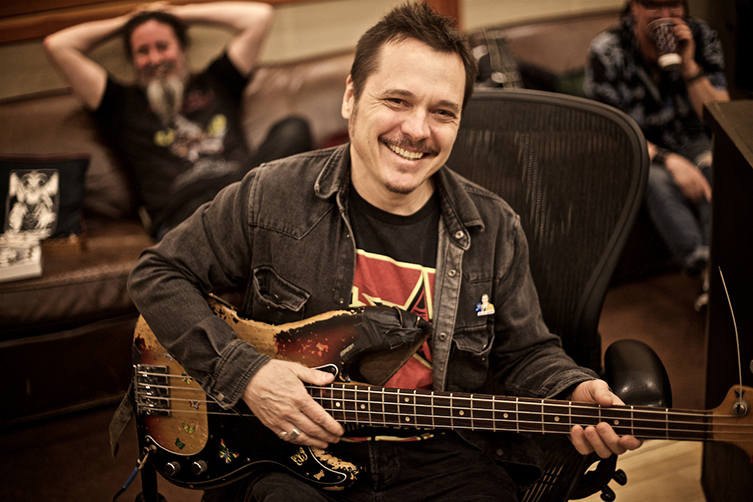
(Photo: Husty Höskulds)
The Secret Song is a parallel groove on the vinyl. When it goes into its ‘host’ song, Carry Stress in the Jaw, you would have to lift the needle up and drop it back down. About half the time, maybe even 30% of the time, you would drop it down on the Secret Song that was imbedded within (laughs). Truly fucking hidden completely! A hidden song. And for the CD, there’s a thing you can do called pre-roll, which is to index a song before the beginning of an album. When the CD comes on it starts at the beginning as usual and you would only know about that pre-roll if you hit rewind. Nobody would fucking know about this song, it’s the ultimate Easter egg!
So, what happened was, Danny found out. He came into the studio when we were working on it or something and went, ‘what the hell’s this?’, so he knew. Trevor didn’t know about it, but one of the engineers neglected to remove the rough mix from Trevor’s thing. So, we heard this later, but we figured that the cat is out of the bag, I wonder is Trevor is pissed that we didn’t tell him. We weren’t sure because he didn’t say anything! (laughs) We found out later that it was because he listened to the thing and didn’t pay any attention to it, he thought we were just messing around in the studio. So, it didn’t even phase him, but we were really worried! Then Trevor lets Danny and I know that he had heard it. The one guy who wouldn’t know – because he was on tour with Faith No More – if we did something further, would be Mike! So, we thought: ‘Let’s put some vocals on this fucking song!’
GG: Amazing!
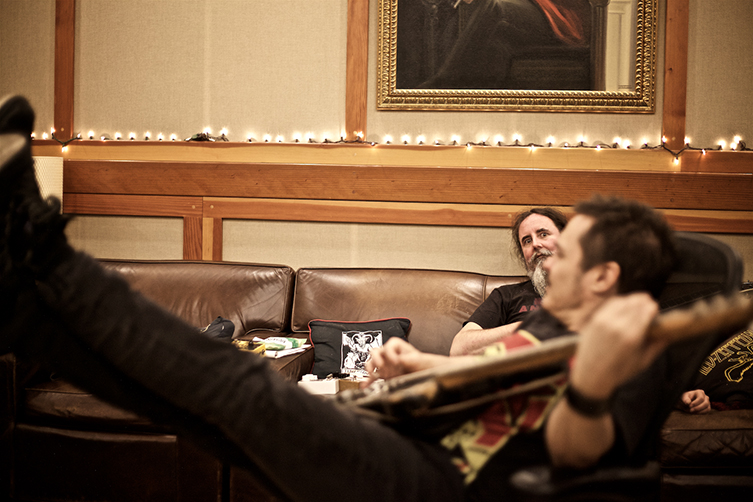
(Photo: Husty Höskulds)
TS: Trevor did that vocal, which is all about how we didn’t tell him about the secret song. That was gonna be like this (raises middle finger jokingly) to Patton. Oh man, and then Patton...he got us so bad. The record came out, and he wasn’t around for the mastering and all that stuff, so he hadn’t heard the masters: it was a secret we could keep from him. The record came out, and everyone talks on the phone and everything, and he didn’t say anything. He was just silent. He wouldn’t talk to us for, like, a week. Then, I don’t remember if he wrote us or left us phone messages in the middle of the night, but he was like: ‘You fucking bastards!’ (laughs) He was totally...like, he chewed us out and we were all ‘Oh no! We really fucked that up!’ and then he was just like ‘Ahh! Got you!’ (laughs) He thought it was hilarious, he was like, ‘This is what happens when you play a practical joke’!
The best part of the story is that the mastering engineer, Bernie Grundman, was able to imbed the song on a 12”. I think it’s the only full-length record that has an imbedded parallel groove that happens in the middle of a side of a record. It’s almost impossible. Seriously, you’re dropping a lathe with a microscope! It’s not possible, he’s a master!
GG: That is amazing! What a great story! I didn’t know any of that: I just have it digitally, so it comes on later on in the tune. It was such a funny surprise the first time I heard that voice, I thought, ‘I really have to ask Trey about that!’ Haha!
TS: And it’s a shame with the digital one. We just made a decision to sequence it with the record because, if you can believe this, on the CDs, a guy had patented the idea – not even the technology – the idea of the pre-roll, to imbed the song before it. So, we were gonna have to pay a royalty (laughs) on every CD! Come on, right?

(Photo: Husty Höskulds)
GG: Nah, no way.
TS: After all that, this motherfucker ruined it! (laughs)
GG: Now, that would be a fantastic story to go out on, but just to round things off finally, when it’s safe to do so, will Mr Bungle be out playing? And will it have Scott and Dave joining?
TS: We don’t have any formal plans yet, but yeah! Everybody wants to do it, and it should happen. It’s something that’s gotta happen, because when we did it here in the US, it was so much fun. The audience was really into it so it would suck to deprive the rest of the world a chance to see something like that.
GG: Totally. Trey, what a fantastic time I’ve had, thank you so much for giving me such a great conversation!
TS: That was great, thanks for the good questions, man!
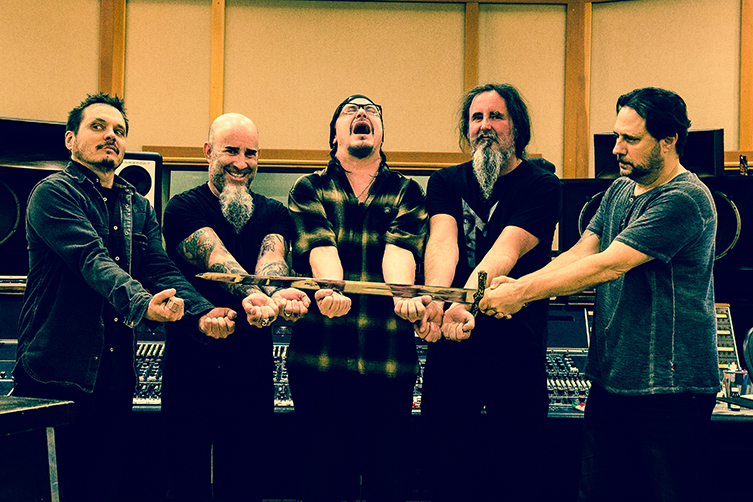
(Photo: Eric Larson)
How lucky, to get both guys to talk to us and be so open! It’s so interesting, seeing the project from the perspective of someone who was intimately involved in its initial creation, and from an industry legend who was brought on board to lend his power and perspective. Collectively, it’s easily one of the best heavy albums of the year. All of that hard work and relentless dedication has paid off, and then some. When they finally get around to playing more shows, it’s going to be unbelievable.
Until then, keep up with Mr Bungle via the official Ipecec Recordings website. Follow Anthrax’s new happenings at the official Anthrax website.
We’d like to wholeheartedly thank Scott and Trey for their time and generosity. We’d also like to thank Lauren Barley for all of her immense help throughout.
But did I ever answer my own initial question?
What kind of band are Mr Bungle?
I don’t know, but in the end, two words come to me, so I’ll offer them up:
Fearless Pioneers.
Thanks for reading, and be sure to have a read through our other artist interviews on our guitarguitar Interview pages.



